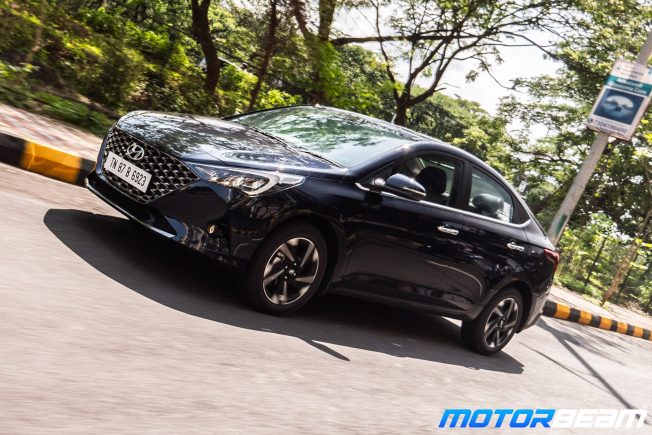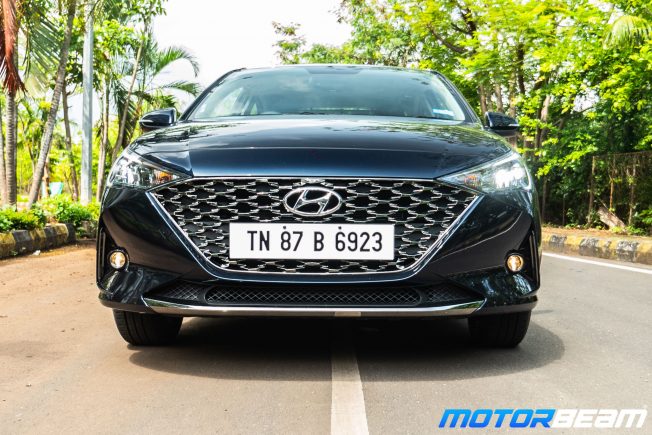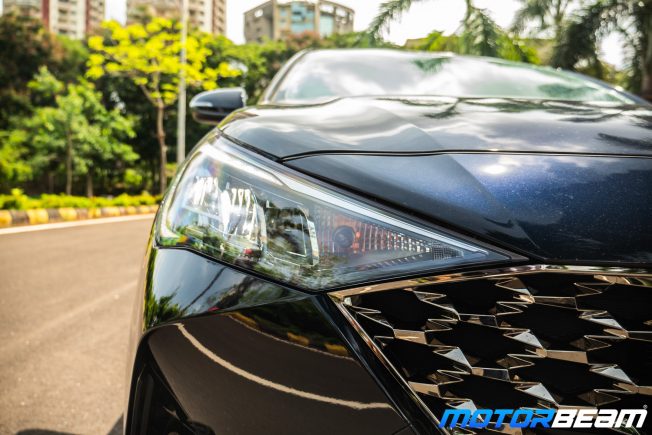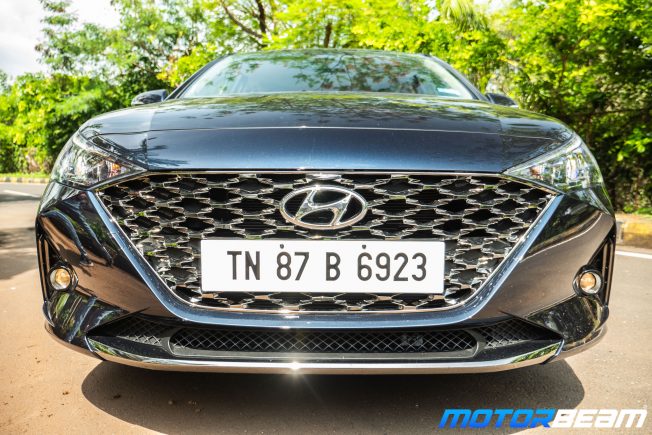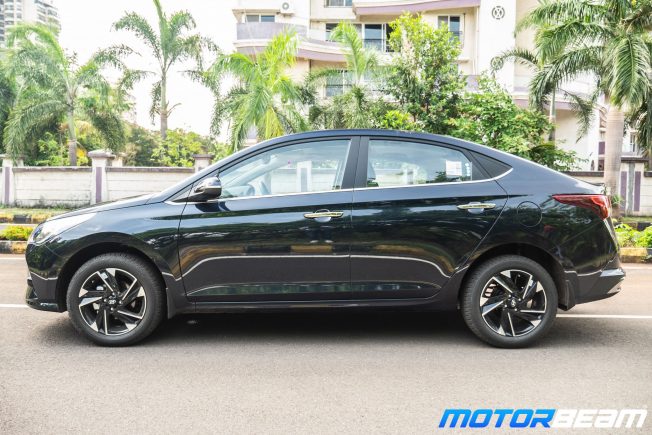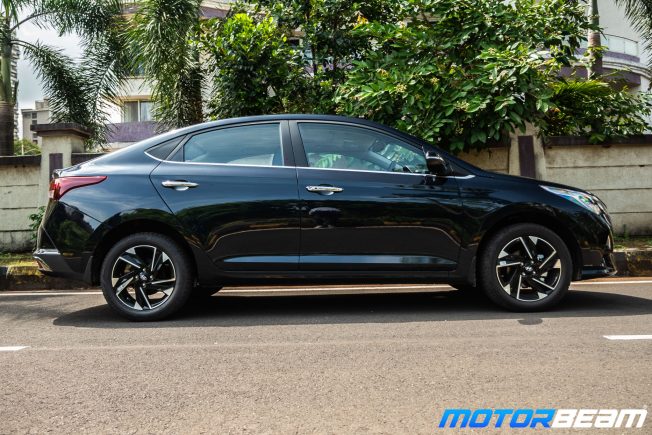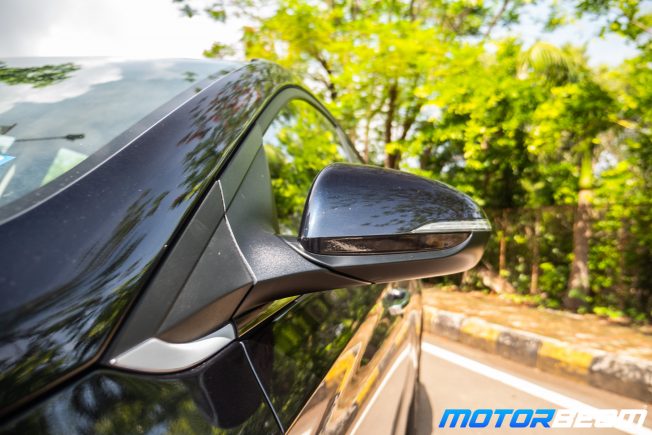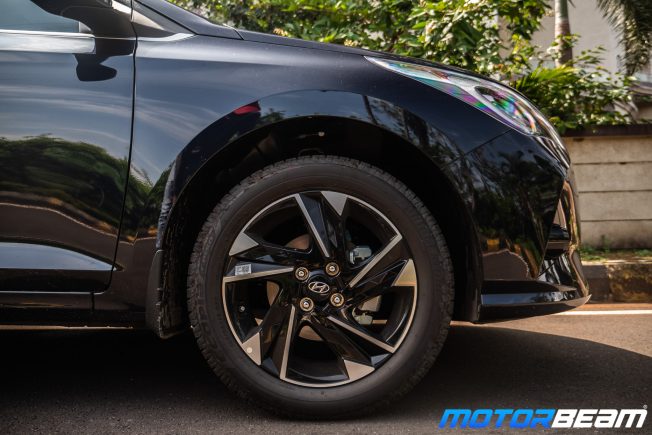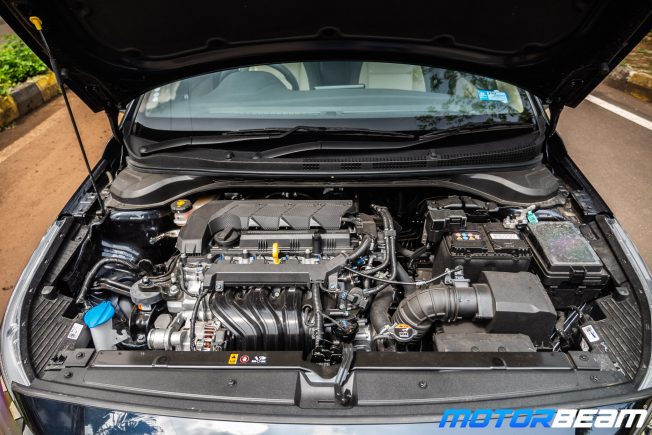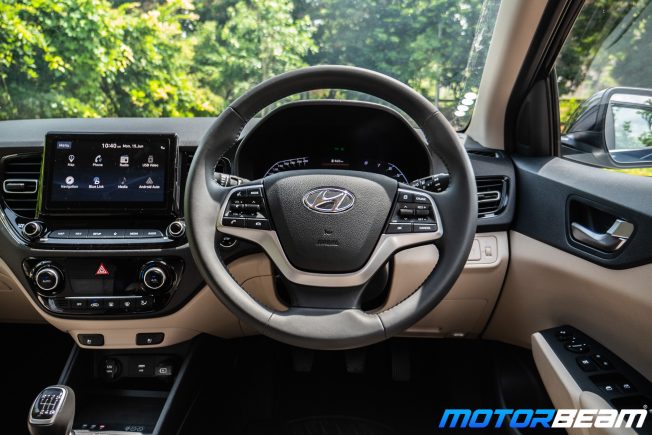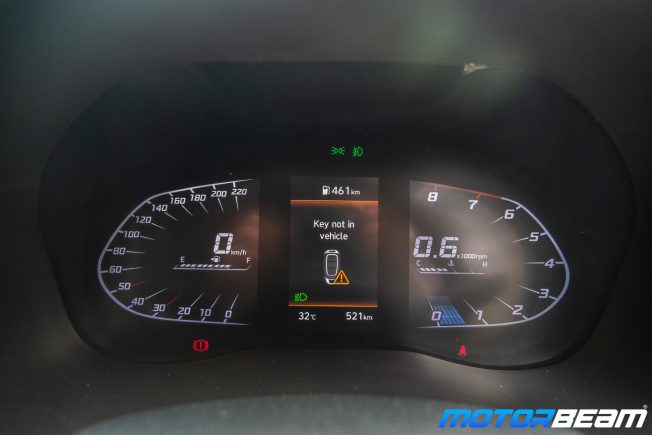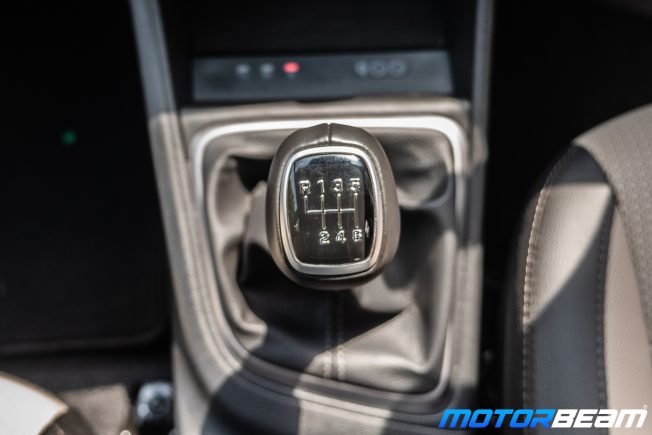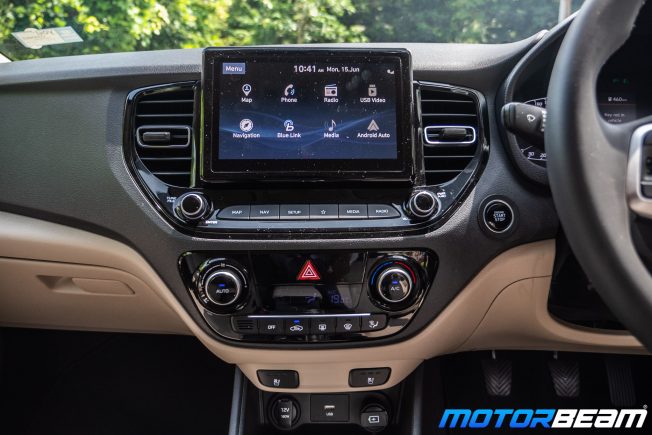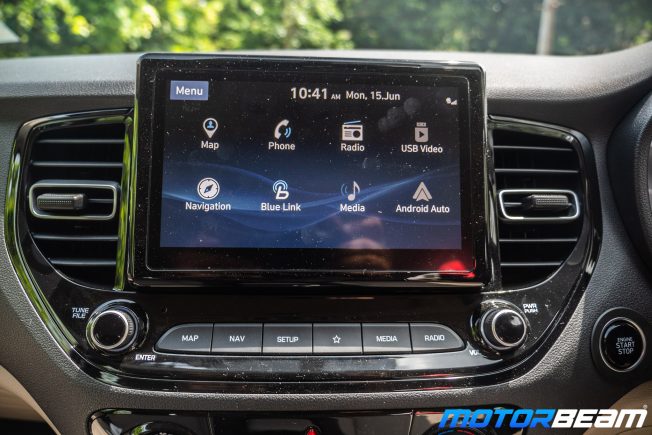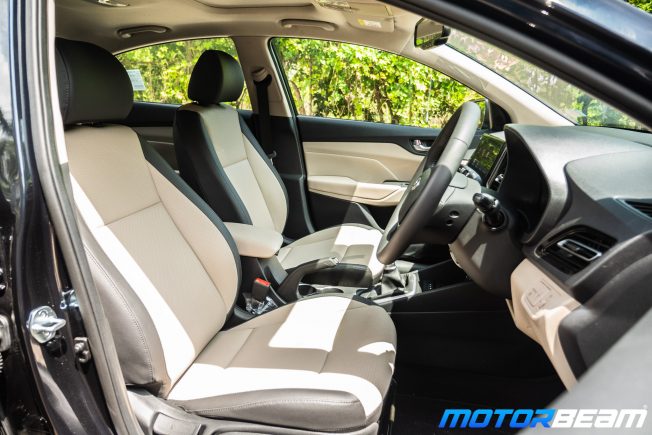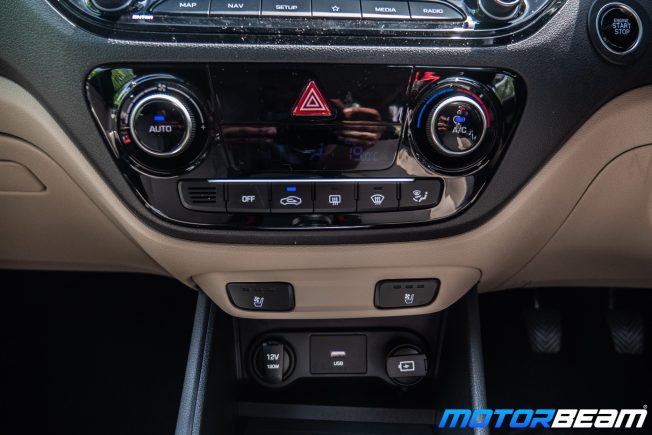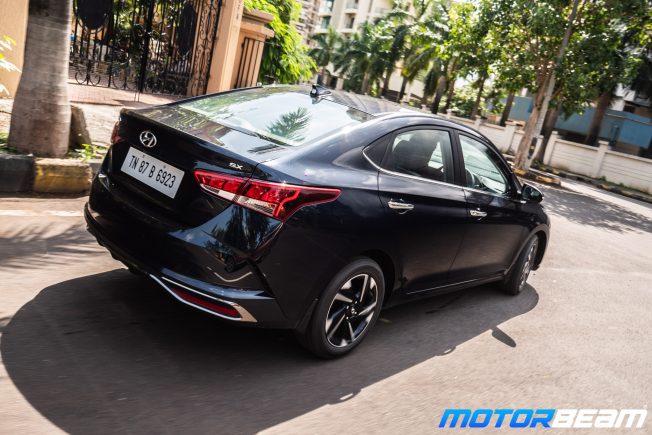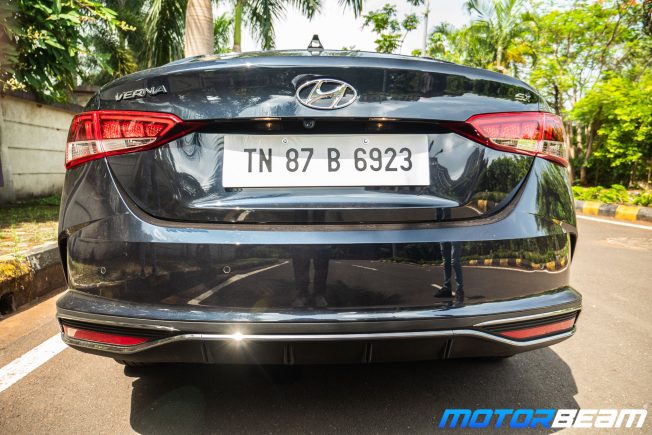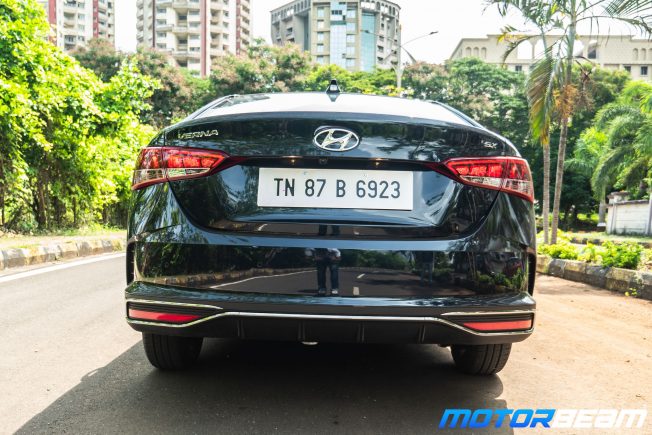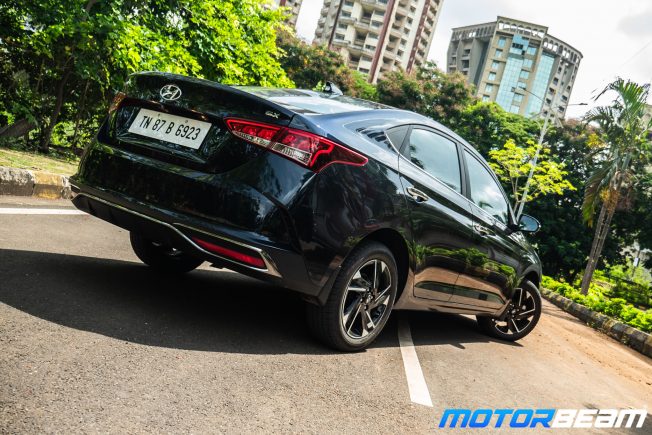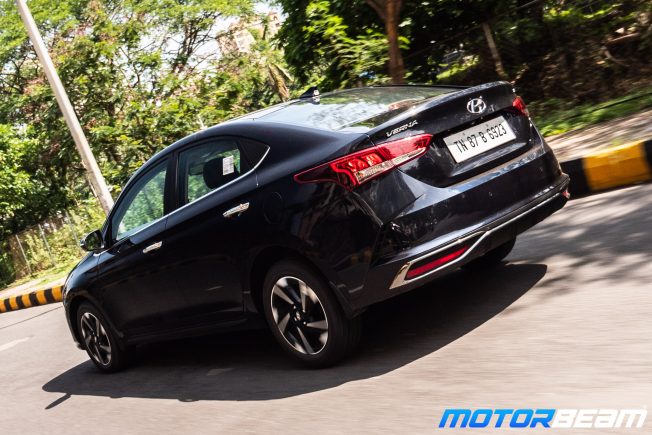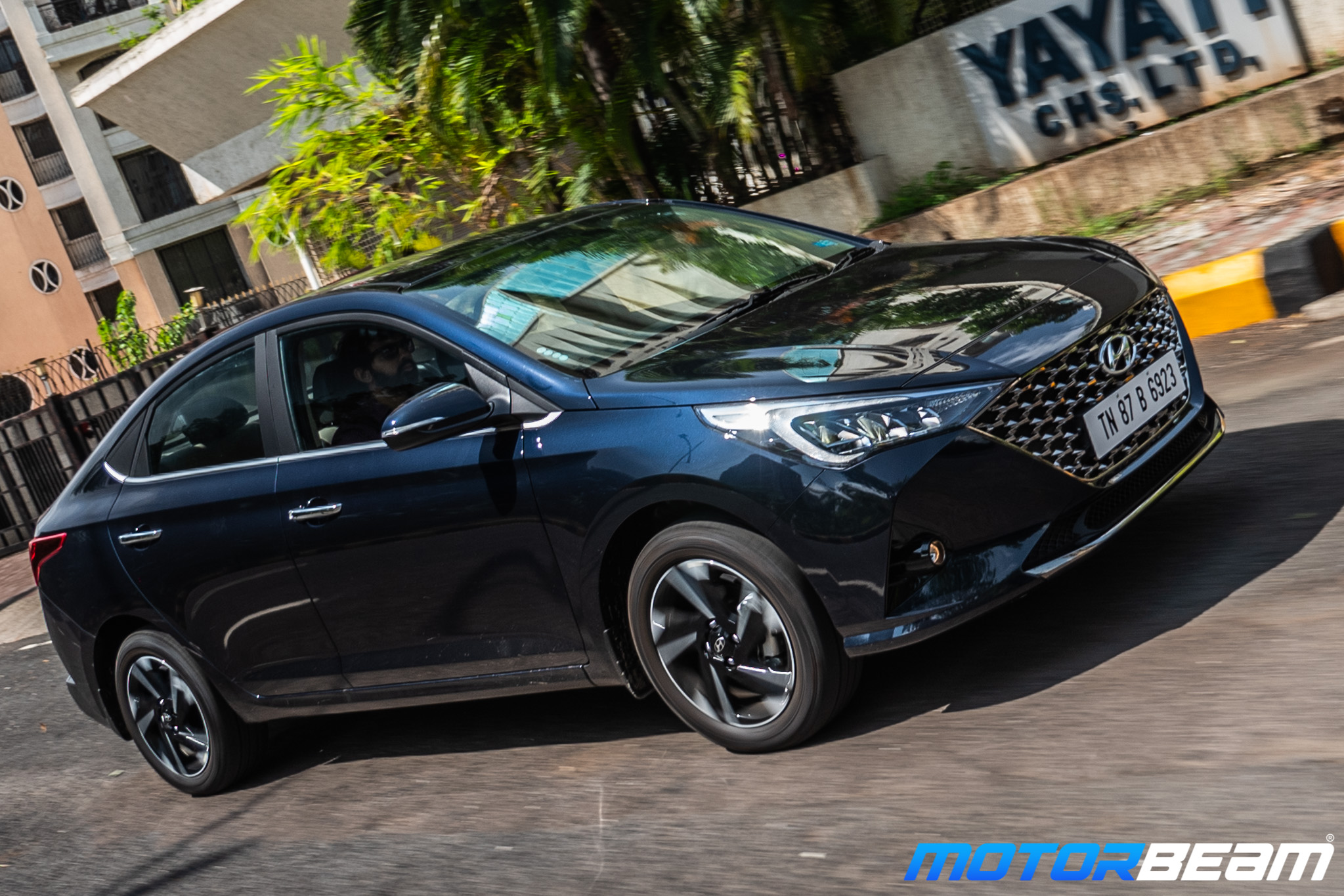
Hyundai launched the Verna back in the year 2006. In the year 2011, Hyundai launched the fluidic Verna, which was famous for its design and was sold in high numbers. In the year 2017, the third generation of the Verna was launched, and in the year 2020, it got a facelift. The Verna is available with multiple powertrains and a host of multiple features. The Verna has a direct competitor, the Honda City, and the City has been a best seller for over the years. Let’s do a thorough analysis of the Verna.
Pros – Attractive Design, Refined And Powerful Engines, Feature Loaded
Cons – Rear Seat Lacks Space, Steering Lacks Feel And Feedback
Hyundai Verna Exteriors
Upfront, the Verna gets a frameless dark chrome grille that looks premium and sporty. The headlights merge seamlessly with the front grille. The headlights get a LED setup, but the indicators and the fog lamps are still halogens. The bumper gets plenty of cuts and creases, and it also gets a mini spoiler. From the side, the coupe-like roofline has been carried over from the previous generation. The 16-inch diamond-cut alloy wheels look nice and sporty. From the rear, it gets a diffuser like treatment with chrome surroundings. The taillights get LEDs, but they are not completely LEDs.
With the Turbo variant, you get a gloss black finish on the front grille, OVRMs, shark fin antenna. The rear bumper also gets a honeycomb-like styling treatment. You also get twin-tip exhaust in the Turbo variant.
Hyundai Verna Interior
The Verna gets black and beige dual-tone treatment interiors. The Turbo variant gets all-black interiors with red accents for the sporty appeal. The overall quality of the cabin is nice, but it uses shiny hard plastics which might not feel premium. The infotainment screen is an 8-inch free-standing touchscreen. The touch response is good and is also crisp to read. The infotainment comes paired with a 6-speaker Arkamys sound system. It gets Apple CarPlay, Android Auto, Bluetooth, & USB connectivity. The Verna comes with Hyundai’s BlueLink application with Vodafone-Idea eSim making this a connected car. The instrument cluster gets a fully digital display. The display looks nice, but as there are no needles it is difficult to read sometimes. Other features include ventilated front seats, sunroof, smart trunk, push-button start/stop, automatic AC, wireless phone charger, cooled glove box, cruise control, driver rearview monitor, auto-dimming IRVM, and much more.
Hyundai Verna Space
The front seats of the Verna are nice and provide a good amount of support. But the biggest disadvantage of the Verna is its rear-seat space. Space is even less compared to some of the compact sedans. The legroom is not great, and the seat isn’t wide enough for three peoples to sit comfortably.
Hyundai Verna Engine Performance
The Hyundai Verna is offered with three engine options. The first one is a 1.5-litre, 4-cylinder, petrol engine churning out 115 PS of power at 6300 RPM and a torque output of 145 Nm at 4500 RPM. This engine comes mated to either a 6-speed manual transmission or a CVT (which Hyundai likes to call IVT). The second one is a 1.0-litre, 3-cylinder, Turbo petrol engine churning out 120 PS of power at 6000 RPM and a torque output of 171 Nm at 1500-4000 RPM. This engine comes mated to a 7-speed DCT. The third one is a 1.5-litre, 4-cylinder, diesel engine churning out 115 PS of power at 4000 RPM and a torque output of 250 Nm at 1500-2750 RPM. This engine comes mated to either a 6-speed manual transmission or a 6-speed automatic transmission.
Talking about the 1.5-litre petrol engine, the engine offers smooth performance and is also very refined. The engine reacts well to the throttle response, and you don’t have to press hard to get the power from the engine. The low and the mid-range of this engine is quite good. However, the power starts to taper off from 4000 RPM, and near the redline, it feels very dull. The 6-speed gearbox is easy to use, and the CVT also has been improved.
The 1.0-litre Turbo petrol engine is smooth and powerful. The engine feels easy to drive in the city traffic. There is some amount of turbo-lag present at low speeds. However, when you put your foot down the gearbox downshifts and gets you moving. With the wide torque band, the acceleration of the Verna feels pretty strong. The gearbox is tuned well with the engine, and you do get paddle shifters to take the manual control of it.
Talking about the 1.5-litre diesel engine, it has some amount of less power and torque compared to the earlier 1.6-litre diesel mill. There is some amount of turbo lag at lower revs, but once you have passed the turbo-lag, the power keeps on developing till 4000 RPM. The engine feels very refined when compared to other diesel engines in the segment. Overall NVH levels of this engine are well contained. The 6-speed manual gearbox is slick to use, and the clutch is also on the lighter side.
Hyundai Verna Mileage
The Verna 1.5-litre petrol has an ARAI rated mileage of 17.7 km/l and 18.4 km/l for manual transmission and CVT, respectively. In real-world conditions, you can expect anywhere between 9-13 km/l in city traffic and 13-16 km/l on highways.
The 1.0-litre Turbo variant with 7-speed DCT has an ARAI rated mileage of 19.2 km/l. In real-world conditions, you can expect anywhere between 10-13 km/l in city traffic and 14-17 km/l on highways.
The Verna diesel has an ARAI rated mileage of 25 km/l and 21.3 km/l for manual transmission and automatic transmission, respectively. In real-world conditions, you can expect anywhere between 12-15 km/l in city traffic and 16-20 km/l on highways. However, fuel efficiency depends on driving conditions, traffic conditions, and other such external factors.
Hyundai Verna Handling
The Verna feels more agile and composed. The steering repose has also been improved compared to the older car. Still, the steering feels light and doesn’t have much amount of feel and feedback, which overall dulls the driving experience.
Hyundai Verna Comfort
There is some amount of body roll, but the overall ride quality has been improved. The suspension works silently and takes the bad patches of the roads easily. You can hear somewhat from the suspensions from huge bumps otherwise, it does its job well.
Hyundai Verna Safety
In terms of safety equipment, the Verna gets dual front airbags, ABS with EBD, front seat belts with pre-tensioner, speed alerts, impact sensing auto door unlock, TPMS, ISOFIX child seat mounts, emergency stop signal, immobilizer driver and passenger seat belt reminder as standard. In the top two trims, you get the additional side and curtain airbags, electronic stability control (ESC), vehicle stability management control (VSM), hill-start control, and theft alarm. The Turbo variant also gets front parking sensors and rear disc brakes.
Hyundai Verna Service
Hyundai has a vast network of service stations across the country. Hyundai’s after-sales service is known to be impressive. Hyundai cars come with a hassle-free, reliable experience.
Hyundai Verna Prices
Following are the prices (on-road Mumbai) of the Verna 1.5-litre Petrol:
- Hyundai Verna E (MT) – Rs. 10.71 lakhs
- Hyundai Verna S+ (MT) – Rs. 11.18 lakhs
- Hyundai Verna SX (MT) – Rs. 12.98 lakhs
- Hyundai Verna SX (IVT) – Rs. 14.40 lakhs
- Hyundai Verna SX (O) (MT) – Rs. 15.15 lakhs
- Hyundai Verna SX (O) (IVT) – Rs. 16.61 lakhs
Following are the prices (on-road Mumbai) of the Verna 1.0-litre Turbo Petrol:
- Hyundai Verna SX (O) (DCT) – Rs. 16.67 lakhs
Following are the prices (on-road Mumbai) of the Verna 1.5-litre Diesel:
- Hyundai Verna S+ (MT) – Rs. 13.00 lakhs
- Hyundai Verna SX (MT) – Rs. 14.66 lakhs
- Hyundai Verna SX (AT) – Rs. 16.03 lakhs
- Hyundai Verna SX (O) (MT) – Rs. 16.91 lakhs
- Hyundai Verna SX (O) (AT) – Rs. 18.27 lakhs
Hyundai Verna Resale Value
The 2020 Verna is relatively new in the market. As it is quite popular in the market, we can expect a good resale value from it. The resale value also depends upon the condition of the car and the total kilometres driven.
Hyundai Verna Colours
The Verna is offered in following colours:
- Starry Night
- Typhoon Silver
- Fiery Red
- Titan Grey
- Polar White
- Phantom Black
Hyundai Verna Specs
Following are the specifications of the BS6 Hyundai Verna:
- Engine:- 1497cc, 4 Cylinder, MPi Petrol | 998cc, 3 Cylinder, Turbo GDi Petrol | 1493cc, 4 Cylinder, U2 CRDi Diesel
- Power:- 115 PS @ 6300 RPM | 120 PS @ 6000 RPM | 115 PS @ 4000 RPM
- Torque:- 145 Nm @ 4500 RPM | 171 Nm @ 1500-4000 RPM | 250 Nm @ 1500-2750 RPM
- Transmission:- 6-Speed MT, IVT | 7-Speed DCT | 6-Speed Manual, 6-Speed Automatic
- Fuel Efficiency (ARAI):- 17.7 km/l (MT) 18.4 km/l (IVT) | 19.2 km/l (DCT) | 25 km/l (MT), 21.3 (AT)
- Fuel Efficiency (Real World):- 9-13 km/l (City) 13-16 (Highway) | 10-13 km/l (City) 14-17 (Highway) | 12-15 km/l (City) 16-20 (Highway)
- Dimensions (L x W x H):- 4440 mm x 1729 mm x 1475 mm
- Wheelbase:- 2600 mm
- Ground Clearance:- 165 mm
- Kerb Weight:- 1040–1170 kgs
- Fuel Tank Capacity:- 45 litres
- Boot Capacity:- 480 litres
- Turning Radius:- 5.2 meters
- Tire Sizes:- 185/65/15 Steel (E), 195/55/16 Styled Steel (S+), 195/55/16 Alloy (SX), 195/55/16 Diamond Cut Alloy (SX(O), SX(O) Turbo) | 185/65/15 Steel (Spare Wheel)
- Suspension:- McPherson Strut with Coil Spring (Front), Coupled Torsion Beam Axle (Rear)
- Brakes:- Disc (Front), Drum (Rear – E, S+, SX, SX(O))/Disc (Rear – SX(O) Turbo)
Hyundai Verna Variants
The Hyundai Verna 1.5-litre 4-Cylinder Petrol MPi is offered in the following variants:
- E (MT)
- S+ (MT)
- SX (MT/IVT)
- SX (O) (MT/IVT)
The Hyundai Verna 1.0-litre 3-Cylinder Turbo Petrol is offered in the following variants:
- SX (O) (DCT)
The Hyundai Verna 1.5-litre 4-Cylinder CRDi Diesel is offered in the following variants:
- E (MT)
- S+ (MT)
- SX (MT/AT)
- SX (O) (MT/AT)
Hyundai Verna Rating
We give the Hyundai Verna a rating of 4/5.
Hyundai Verna Upcoming Models
Right now the company isn’t planning to launch any updated model of the Verna.
Hyundai Verna vs Honda City
The 5th generation of the City is available with 1.5-litre petrol and diesel engine options. The diesel version of the City doesn’t get an automatic transmission. The petrol engine comes with an option of either a 6-speed manual transmission or a CVT. In terms of a diesel engine, the Verna is more powerful than the City. Both the cars are feature-loaded. However, the City excels in terms of rear-seat space and comfort. If you are looking to buy a petrol car, then you should go for the Honda City and if you looking to buy a diesel car, then you should go for the Verna if rear space is not a concern for you. In terms of dimensions, the City is longer by 109 mm, wider by 19 mm, and taller by 14 mm than the Verna.
Hyundai Verna vs Maruti Ciaz
The Ciaz is available with a single 1.5-litre petrol engine. In terms of power and torque output figures of the petrol engine, the Verna has slightly more powerful than the Ciaz. The Ciaz gets a smart hybrid system that isn’t present in any car in this segment. In terms of design, the Verna looks more stylish. While in terms of rear-seat space, the Ciaz takes a lead. In terms of dimensions, the Maruti Ciaz is longer by 50 mm and taller by 10 mm. Both the cars are identical in terms of width.
Hyundai Verna vs Skoda Rapid
The Rapid is available with a single 1.0-litre turbocharged petrol engine. The Rapid is fun to drive car, and the build quality is also impressive. In terms of features, the Rapid misses out on certain features. In terms of dimensions, the Verna is longer by 27 mm, and wider by 30 mm.
Hyundai Verna vs Toyota Yaris
The Yaris is offered with a single 1.5-litre petrol engine paired with either a manual transmission or a CVT. The Yaris isn’t the highest seller, but it gets good safety features too. The Yaris misses out on certain features but on the other hand, it comes with the reliability of Toyota. In terms of dimensions, the Verna is longer by 15 mm than the Yaris. On the other hand, the Yaris is taller by 20 mm than the Verna.


